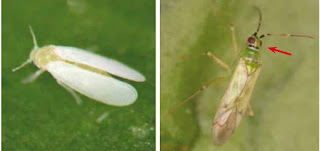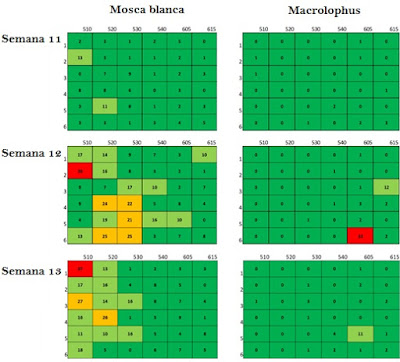Emerging plant pests and diseases in Tomato and Pepper Symposium
Un simposio en Bélgica para difundir resultados del I+D en un DSS
PeMaTo-Europep es un proyecto C-IPM ERA-NET donde IFAPA participa juntos con investigadores de la Universidades de Amberes (Bélgica) y Wageningen (Holanda), y Centros de Investigación Hortícola de Hoogstraten y Sint-Katelijne-Waver (Bélgica). Uno de los objetivos principales del proyecto es que productores de tomate puedan reducir significativamente el uso de tratamientos químicos para combatir plagas como la mosca blanca. Tras un seguimiento de plagas y enemigos naturales en invernaderos, se pretende construir modelos que describen la evolución ecológica de los dos tipos de artrópodos. Por el otro lado, se desarrolla un sistema de captación de imagen a partir de trampas cromatrópicas amarillas colocadas en invernaderos de tomate, así como un sistema de reconocimiento que computa la mosca blanca Bemisia tabaci y su enemigo naturale Nesidiocoris tenuis. La combinación de los modelos ecológicos, con los datos obtenidos en el invernadero sobre la plaga más enemigos naturales presentes en un cultivo, permite predecir si el control biológico sería suficiente para combatir la plaga. De este manera, el método se convierte en una herramienta de soporte de decisión que podría dar recomendaciones racionales al productor sobre si debe intervenir o no, si puede prescindir de un tratamiento químico o no.
Bemisia tabaci (left) and Nesidiocoris tenuis (right)
Los resultados de la investigación coordinada entre los diferentes países fue presentado en un simposio internacional, “Montoring and Management of Current and Emerging Plant Pests and Diseases in Tomato and Bell Pepper”, en el Campus Tecnológico de la Universidad de Lovaina en Sint-Katelijne-Waver (Bélgica) el pasado 15 y 16 de enero. Desde IFAPA Centro La Mojonera, fuimos (Dirk Janssen, Maria de Mar Téllez y Estefanía Rodríguez) y explicamos la particular situación de la horticultura almeriense, sus principales características y retos para consolidar el control biológico en los invernaderos. En una conferencia y un póster presentamos los resultados del seguimiento hecho en invernaderos de tomate en el poniente y levante de Almería. Los conclusiones preliminares muestran la gran potencia de Nesidiocoris tenuis para instalarse en los cultivos y contribuir significativamente al control de mosca blanca.
Demonstration of DSS with image capturing, detection, identification, couting and modelling of whitefly and natural enemy
El gran avance en conseguir los objetivos comunes del proyecto por parte de los diferentes grupos de investigación ha quedado claro en el simposio, demostrando en este caso las grandes ventajas de la colaboración. La horticultura de invernadero en Andalucía y en los países como Bélgica y Holanda tiene importantes diferencias por la situación climática, socio-económica y tecnológica de cada una, pero ambos están en continua evolución. El uso de luces LED está permitiendo que países del norte puedan seguir cultivando en pleno invierno, que es precisamente la estación cuando Almería tiene su máxima exportación de género. Por el otro lado, esta nueva tecnología está provocando que los productores amplíen el periodo de cultivo durante todo el año, favoreciendo la propagación de plagas, incluida la mosca blanca Bemisia tabaci, muy conocida en países mediterráneos. Más importante es que los productores, tanto en Almería como en Bélgica y Holanda, tienen los mismos retos: conseguir una producción hortícola competitiva, más sana para el consumidor y segura para el productor, y esto se consigue primero evitando tratamientos químicos innecesarios. Por ello, la nueva herramienta de soporte de decisión desarrollada en el seno del presente proyecto pretende ayudar a conseguir estos objetivos.
--------------------------------------------------------
PeMaTo-Europep is a C-IPM ERA-NET project where IFAPA participates together with researchers from the Universities of Antwerp (Belgium) and Wageningen (Holland), and Horticultural Research Centers of Hoogstraten and Sint-Katelijne-Waver (Belgium). One of the main objectives of the project is that tomato producers can significantly reduce the use of chemical treatments to combat pests such as whitefly. After monitoring pests and natural enemies in greenhouses, we intend to build models that describe the ecological evolution of the two types of arthropods. On the other hand, an image acquisition system is developed from yellow chromatic traps placed in tomato greenhouses, as well as a recognition system that computes the whitefly Bemisia tabaci and its natural enemy Nesidiocoris tenuis. The combination of the ecological models, with the data obtained in the greenhouse on the pest plus natural enemies present in a crop, allows to predict if the biological control would be enough to control the pest. In this way, the method becomes a decision support tool that could give rational recommendations to the producer on whether or not to intervene, whether it can dispense with a chemical treatment or not.
The results of the coordinated research between the different countries was presented at an international symposium, "Montoring and Management of Current and Emerging Plant Pests and Diseases in Tomato and Bell Pepper," at the Technological Campus of the University of Leuven in Sint-Katelijne- Waver (Belgium) on 15 and 16 January. From IFAPA Centro La Mojonera, we went (Dirk Janssen, Maria de Mar Téllez and Estefanía Rodríguez) and explained the particular situation of the Almeria horticulture, its main characteristics and challenges to consolidate the biological control in the greenhouses. In a conference and a poster we present the results of the monitoring done in tomato greenhouses in the west and east of Almería. The preliminary conclusions show the great power of Nesidiocoris tenuis to settle in the crops and contribute significantly to the control of whitefly.
The significant progress in achieving the common objectives of the project by the different research groups has been made clear in the symposium, demonstrating in this case the great advantages of collaboration. Greenhouse horticulture in Andalusia and in countries such as Belgium and the Netherlands have important differences due to the climatic, socio-economic and technological situation of each one, but both are in continuous evolution. The use of LED lights is allowing northern countries to continue cultivating in the middle of winter, which is precisely the season when Almeria has its maximum export of produce. On the other hand, this new technology is causing producers to extend the period of cultivation throughout the year, favoring the spread of pests, including the whitefly Bemisia tabaci, well known in Mediterranean countries. More important is that producers, both in Almeria and in Belgium and the Netherlands, have the same challenges: to achieve a competitive horticultural production, healthier for the consumer and safe for the producer, and this is achieved first by avoiding unnecessary chemical treatments. Therefore, the new decision support tool developed within the present project aims to help achieve these objectives.






Comentarios
Publicar un comentario